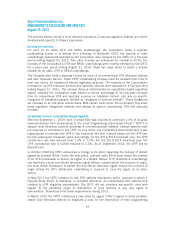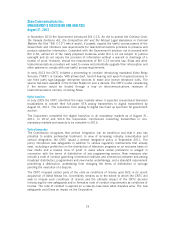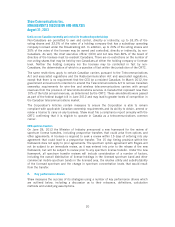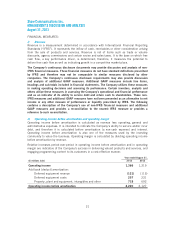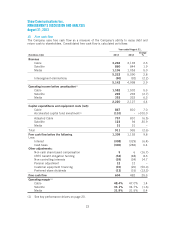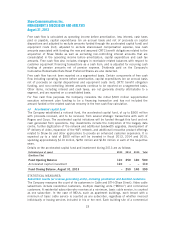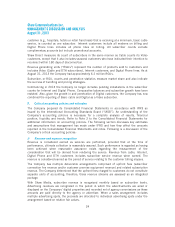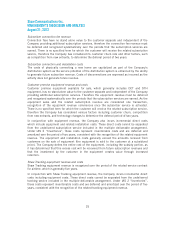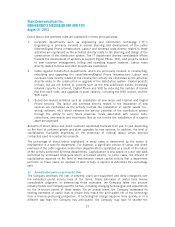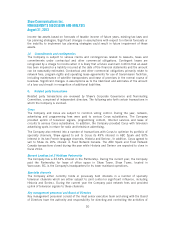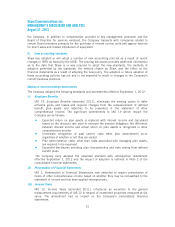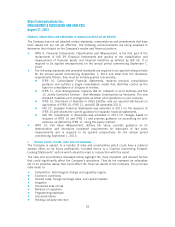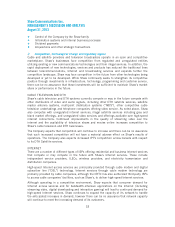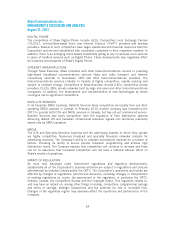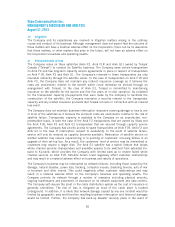Shaw 2013 Annual Report Download - page 30
Download and view the complete annual report
Please find page 30 of the 2013 Shaw annual report below. You can navigate through the pages in the report by either clicking on the pages listed below, or by using the keyword search tool below to find specific information within the annual report.S
haw
C
ommunications Inc
.
MANA
G
EMENT’
S
DI
SCUSS
I
O
N AND ANALY
S
I
S
August
31
,
2013
S
haw Bus
i
ness
i
nstallat
i
on revenue and ex
p
ense
s
The Company also receives installation revenues in its Shaw Business operation on contracts
with commercial customers which are deferred and recognized as revenue on a straight-lin
e
bas
i
s over the related serv
i
ce contract,
g
enerall
y
s
p
ann
i
n
g
two to ten
y
ears. D
i
rect an
d
incremental costs associated with the service contract, in an amount not exceeding the upfron
t
installation revenue, are deferred and reco
g
nized as an o
p
eratin
g
ex
p
ense on a strai
g
ht-lin
e
bas
i
s over the same
p
er
i
od.
I
ncome statement classificatio
n
The
C
om
p
an
y
d
i
st
i
n
g
u
i
shes amort
i
zat
i
on o
f
de
f
erred e
q
u
ip
ment revenue and de
f
erred
equipment costs from the revenue and expenses recognized from ongoing service activities on
its income statement. Equipment revenue and costs are deferred and recognized over the
ant
i
c
ip
ated term o
f
the related
f
uture revenue
(i
.e., the monthl
y
serv
i
ce revenue
)
w
i
th th
e
per
i
od o
f
recogn
i
t
i
on spann
i
ng two to
fi
ve years. As a result, the amort
i
zat
i
on o
f
de
f
erred
equipment revenue and deferred equipment costs are non-cash items on the income statement
,
s
i
m
i
lar to the
C
om
p
an
y
’s amort
i
zat
i
on o
f
de
f
erred IRU revenue, wh
i
ch the
C
om
p
an
y
als
o
segregates
f
rom ongo
i
ng revenue. Further, w
i
th
i
n the l
if
ecycle o
f
a customer relat
i
onsh
i
p, the
customer generally purchases customer premise equipment at the commencement of the
customer relat
i
onsh
ip
, whereas the subscr
ip
t
i
on revenue re
p
resents a cont
i
nuous revenue
stream throughout that customer relat
i
onsh
i
p. There
f
ore, the segregated presentat
i
on prov
i
des a
clearer distinction within the income statement between cash and non-cash activities and
between u
p
-
f
ront and cont
i
nuous revenue streams, wh
i
ch ass
i
sts
fi
nanc
i
al statement readers t
o
pred
i
ct
f
uture cash
f
lows
f
rom operat
i
ons
.
ii)
Allowance
f
or doubt
f
ul account
s
The ma
j
or
i
ty o
f
the
C
ompany’s revenues are earned
f
rom sell
i
ng on cred
i
tto
i
nd
i
v
i
dua
l
subscribers. Because there are some customers who do not pay their debts, selling on credi
t
n
ecessar
i
l
yi
nvolves cred
i
t losses. The
C
om
p
an
yi
sre
q
u
i
red to make an est
i
mate o
f
an
appropr
i
ate allowance
f
or doubt
f
ul accounts on
i
ts rece
i
vables. In determ
i
n
i
ng
i
ts est
i
mate, th
e
Company considers factors such as the number of days the account is past due, whether or no
t
t
he customer cont
i
nues to rece
i
ve serv
i
ce, the
C
om
p
an
y
’s
p
ast collect
i
on h
i
stor
y
and chan
g
es
i
n
bus
i
ness c
i
rcumstances. The est
i
mated allowance requ
i
red
i
s a matter o
fj
udgement and the
actual loss eventually sustained may be more or less than the estimate, depending on event
s
wh
i
ch have
y
et to occur and wh
i
ch cannot be
f
oretold, such as
f
uture bus
i
ness,
p
ersonal an
d
economic conditions. Conditions causing deterioration or improvement in the aging of account
s
receivable and collections will increase or decrease bad debt expense.
iii) Pro
p
ert
y
,
p
lant and e
q
ui
p
ment and other intan
g
ibles – ca
p
italization of direct labour and
o
verhea
d
The cost o
fp
ro
p
ert
y
,
p
lant and e
q
u
ip
ment and other
i
ntan
gi
bles
i
ncludes d
i
rect construct
i
on o
r
d
evelopment costs (such as materials and labour) and overhead costs directly attributable t
o
t
he construction or development activity. The Company capitalizes direct labour and direc
t
o
verhead
i
ncurred to construct new assets, u
pg
rade ex
i
st
i
n
g
assets and connect ne
w
subscribers. These costs are capitalized as they are directly attributable to the acquisition
,
construction, development or betterment of the networks or other intangibles. Repairs and
m
a
i
ntenance ex
p
end
i
tures are char
g
ed to o
p
erat
i
n
g
ex
p
enses as
i
ncurred.
26


